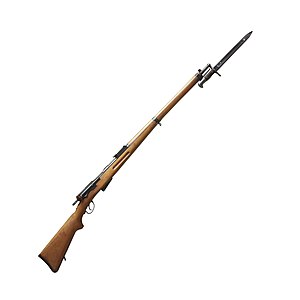Schmidt–Rubin
| Schmidt–Rubin rifles | |
|---|---|

Schmidt–Rubin Infanteriegewehr Modell 1911
|
|
| Type | Bolt action rifle |
| Place of origin | Switzerland |
| Service history | |
| In service | 1889–Present |
| Used by | Swiss Army |
| Production history | |
| Designer | Eduard Rubin and Rudolph Schmidt |
| Manufacturer | W+F Bern |
| No. built | 1,366,228 |
| Specifications | |
| Cartridge |
7.5×53.5mm Swiss (GP90 & GP 90/03) 7.5×54.5mm Swiss (GP90/23) |
| Action | Straight-pull bolt action |
The Schmidt–Rubin rifles were a series of Swiss Army service rifles in use between 1889 and 1958. They are distinguished by the straight-pull bolt action invented by Rudolf Schmidt and use Eduard Rubin's 7.5×55mm Schmidt–Rubin rifle cartridge.
The Model 1889 was the first in the series of Schmidt–Rubin rifles which served Switzerland from 1889 to 1953. The rifle takes its name from the designer of its action, Colonel Rudolf Schmidt, and the designer of its ammunition, Colonel Eduard Rubin. Production of the rifle began in 1891. The straight-pull bolt action allows the user to pull the bolt straight back to unlock the action and eject the spent cartridge in one motion, and push the bolt forward to chamber a round, cock the striker, and lock the action. This is as opposed to a traditional bolt action, wherein the user must lift the bolt handle to unlock the action before pulling the bolt back. The rifle is roughly musket length with a free-floating barrel, 12-round magazine and wood stock that extends almost to the tip of the barrel. The Schmidt–Rubin 1889 was an advanced weapon for its time. The Schmidt–Rubin 1889 was one of the first rifles to use copper-jacketed ammunition as its standard ammunition. The GP90 7.5×53.5mm round designed by Col. Rubin in 1882 was revolutionary in that most of the bullets used in Europe at the time, except for the Mle 1886 Lebel rifle metal-jacketed 8mm bullet, were around .45 inches as opposed to the .308 inches of the Schmidt–Rubin ammunition. Strangely enough the round was "paper patched" meaning that the bullet was surrounded by a piece of paper, much like the cotton patches placed around a musket ball. Paper patching the round was supposed to aid in the lubrication of the bullet. In 1923, long after the discontinuation of the Model 1889, the GP90/23 7.5×53.5mm round was produced without the paper patching. The Model 1889 was eventually replaced by its successor models including the Model 1896, Model 96/11, Model 1911, Model 1911 carbine and the famous K-31.
The Schmidt–Rubin Model 1896 was the replacement for the 1889. Almost all the 1896 were converted to 96/11.
The Schmidt–Rubin 1896/11 Rifle or the Model 96/11 was Switzerland's effort to upgrade the 1896 rifles it currently issued to use the more powerful cartridges of the Model 1911.
...
Wikipedia
